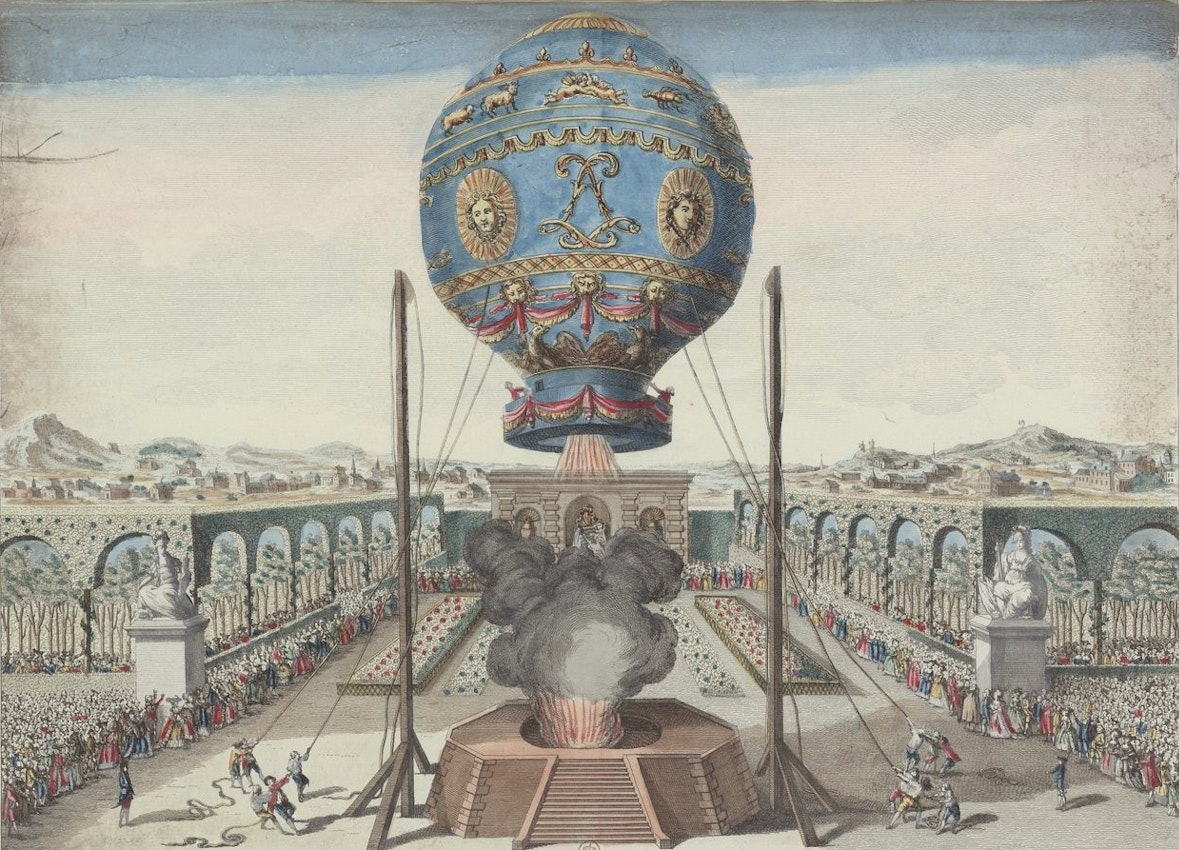 Scroll through the whole page to download all images before printing.
Scroll through the whole page to download all images before printing.Claude-Louis Desrais image of the ascent in a tethered hot air balloon made by Jean-Francois Pilatre de Rozier, 1783 — Source.
Ten years ago today — on 1st January 2011 — we launched The Public Domain Review! Since this auspicious day we’ve published 272 essays, 935 collection posts, featured 134 cultural archives and institutions, and welcomed a whopping 17 million of you to the site. We will be marking this momentous milestone of our tenth birthday with a number of exciting things, to be revealed over the next weeks and months. But for now, on the day itself, we thought it’d be fitting to treat you to a year-by-year glance back over the last decade of the project.
2010
As anyone who has given birth will tell you, there’s goings-on well before the big day itself, and so it was with The Public Domain Review. The co-founders — Adam Green and Jonathan Gray — were living a life of great frugality and freedom in Berlin, spending far too long immersed in various online archives in search of images for collages and other (mostly unrealised) artworks. From these hours of scouring sprung a very modest and very unvisited blog to share our favourite finds — a proto-PDR named Pingere. The seeds were sown, or at least in hand. The idea then came to turn this love for exploring online troves into a bigger project. While finishing his PhD, Jonathan was working with the Open Knowledge Foundation, an organisation doing great work raising awareness of the public domain and pushing for out-of-copyright works to stay so when they went online. When they put in a funding bid to the Shuttleworth Foundation for projects to promote the public domain, the idea for The Public Domain Review was worked in, and so a small pot of seed-funding secured! The little wheels were in motion.
2011
On the 1st January 2011 — on Public Domain Day — we were born! At first we just published essays (or “articles” as we then termed them). Here’s what the homepage looked like for the first half a year or so…
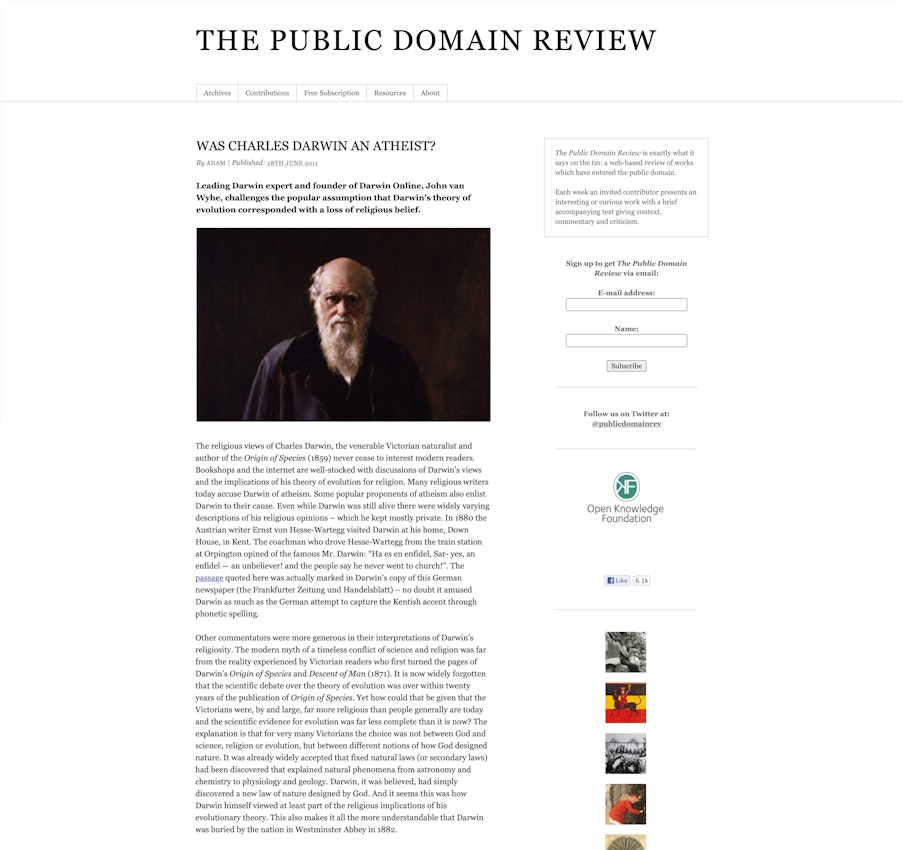 Scroll through the whole page to download all images before printing.
Scroll through the whole page to download all images before printing.Our homepage in July 2011
A scant and simple affair. But in August we changed things up considerably and had a kind of second launch. We expanded the content beyond just “articles” to include smaller pieces, written in-house, highlighting particular public domain works, what we called (and still do call) Collection posts. This was accompanied by a significant revamp of the site design — introducing things we still retain today, such as our logo (thank you Kat Braybrooke!) and the symmetrical layout.
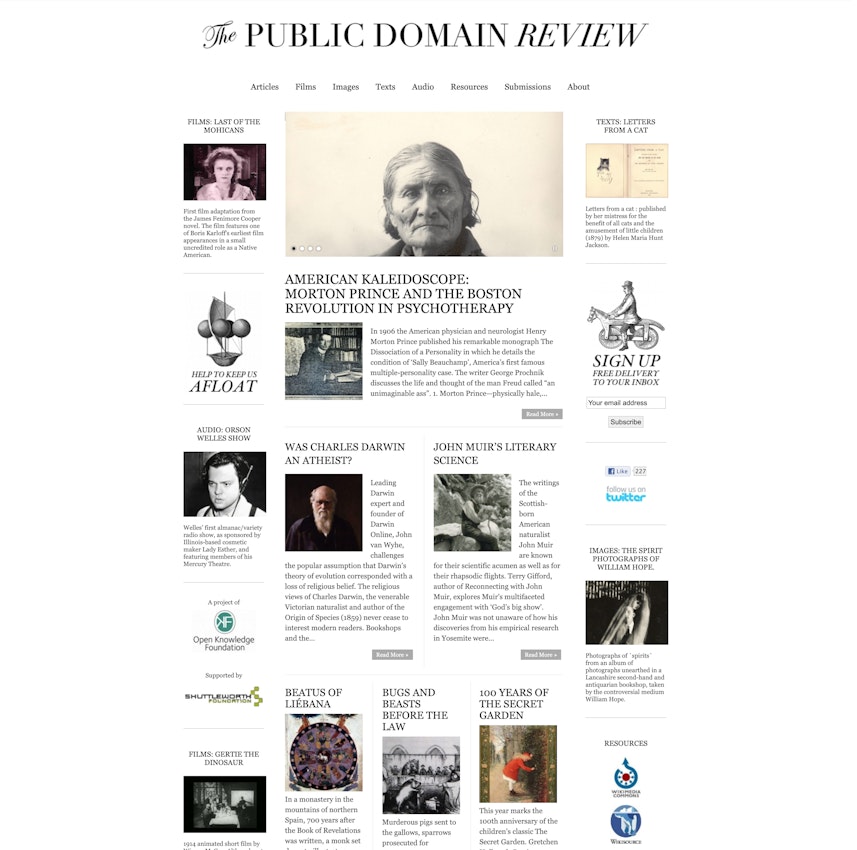 Scroll through the whole page to download all images before printing.
Scroll through the whole page to download all images before printing.Our homepage in August 2011.
2012
The beginning of the year saw a little tweak to the design: the all-important donate and sign up boxes fixed into prominent positions, as they would stay for many a year.
 Scroll through the whole page to download all images before printing.
Scroll through the whole page to download all images before printing.Our homepage in February 2012.
Things ambled along calmly enough until the summer when we saw one of our posts — on retro-futuristic visions of France in the year 2000 — go “viral”. Overnight our traffic increased forty-fold , a spike of attention which proved instrumental in spreading the word of the project. Here’s our analytics graph of the year’s traffic.
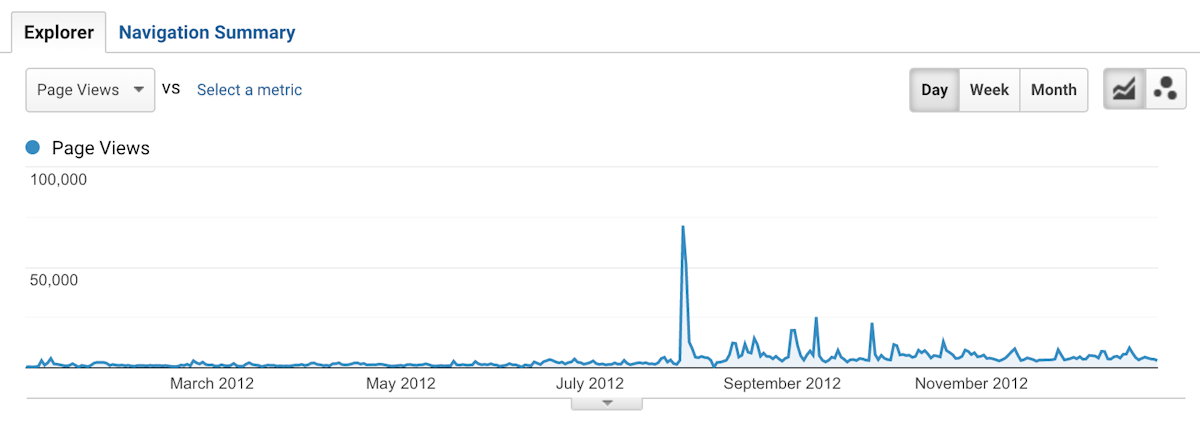 Scroll through the whole page to download all images before printing.
Scroll through the whole page to download all images before printing.Content highlights from the year:
2013
With the seed funds long gone, in the spring we launched our first major fundraiser with a goal to reach $20,000. The campaign was intense but a great success and offered fans, in the campaign’s promo film, a rare (and to this day singular) glimpse of the enigmatic and elusive Editor.
With funding for the next couple of years secured we poured our energies into expanding operations. In partnership with Open GLAM (another Open Knowledge project) we started up of the Curator’s Choice series which each month (until it ceased in 2016) featured a special guest post from a gallery, library, archive or museum curator reflecting upon a group of works in one of their open digital collections. We also began our Caption Competition, which we ran on and off for the next few years, and which we are bringing back very soon!
As is customary, we also continued the ever-tinker to the look of the site.
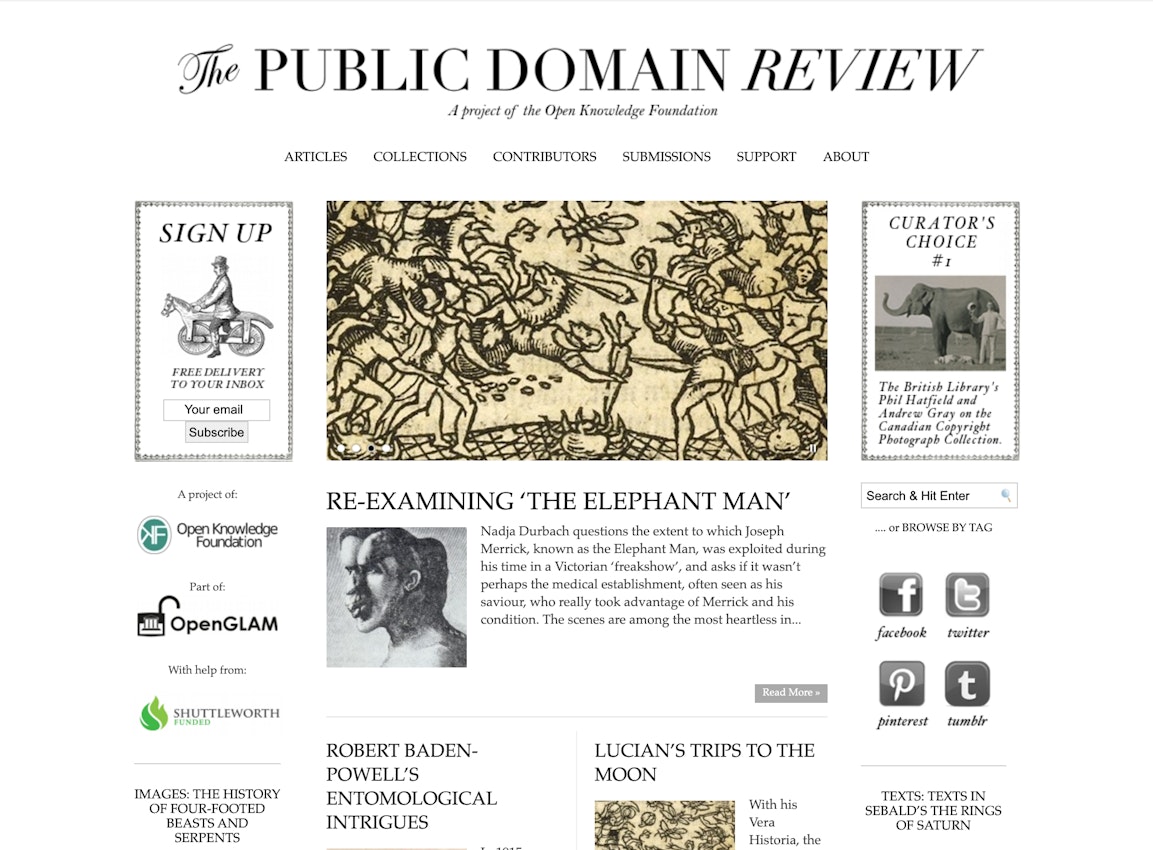 Scroll through the whole page to download all images before printing.
Scroll through the whole page to download all images before printing.Our homepage in August 2013.
In the autumn we launched the first incarnation of our shop (some t-shirts, mugs and posters, though not the high-quality archival prints we do now), and, adding to an interview in Vice earlier in the year, we also had the honour of being featured in the UK’s Guardian / Observer newspaper, who very kindly called us “the best thing on the web” and “a model of digital curation”. (A quote which we then dutifully plastered everywhere.)
2014
In the spring we launched a new look for the site, getting rid of that somewhat suspect image carousel on the homepage and bringing in sections for each of our major content categories, Essays, Images, Books, Film, and Audio — and also introducing the crest symbols which helped define our aesthetic.
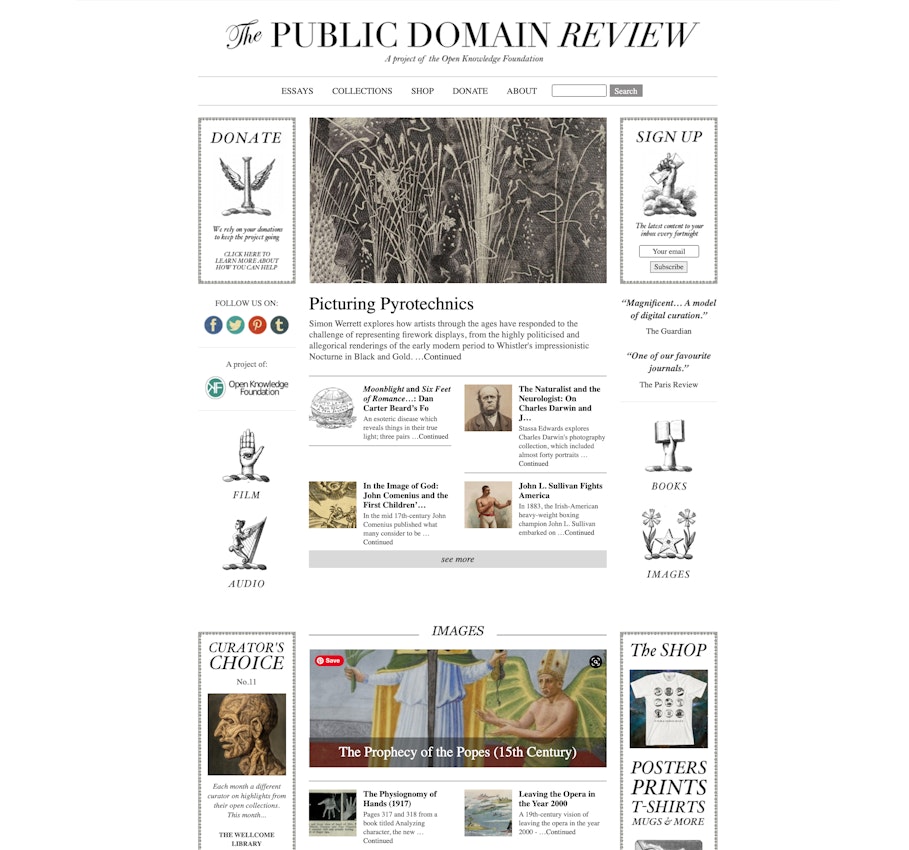 Scroll through the whole page to download all images before printing.
Scroll through the whole page to download all images before printing.Our homepage in July 2014.
The end of the year saw the launch of our very own publishing wing, the PDR Press, and with it our very first book of selected essays! The book was a big one, a bumper 3-in-1 edition featuring our best pieces from our first three years.
2015
The major development for this year, and general saviour for the project, was the launch of our Friends of the Public Domain Review. It quickly became, and continues to be, the beating heart of the site and what makes this all possible.
This was also the year that the Editor eventually succumbed to the tide of technological progress and acquired a smartphone. Which meant PDR finally also got an Instagram account (now our biggest social media platform by quite some way).
2016
This year PDR Press made a brief foray into books extra to the Selected Essays series: in the spring Lucian’s Dialogues of the Gods, and in the summer “Oh Excellent Air Bag”: Under the Influence of Nitrous Oxide. We’ve since had to focus our limited resources on managing the ever-demanding site growth but doing further such books is something we really hope to get to soon.
The other big development of the year was the birth of our Conjectures series. The brainchild of D. Graham Burnett, who acts as series editor, Conjectures serves as a kind of laboratory for experiments with historical form and historical method.
Content highlights from the year:
2017
The start of the year marked a big step in the development of the project — after six years under the umbrella of the Open Knowledge Foundation we were now stepping out on our own. While they never funded us directly, the Foundation were instrumental in securing the initial pot of funding and since provided us with an important administrative home which involved very cost-effective hosting, accounting, and invaluable tech support. So it was a slightly nerve-wracking move but also exciting.
In this new state we needed more money, and so came the idea of starting to offer fine art prints of some of our favourite images. After many months of image editing the PDR Prints Shop launched to great fanfare (and some website crashing) in November. Accompanying it was a new-look website, eschewing the busy flanks that adorned most pages for now a slightly more spacious feel.
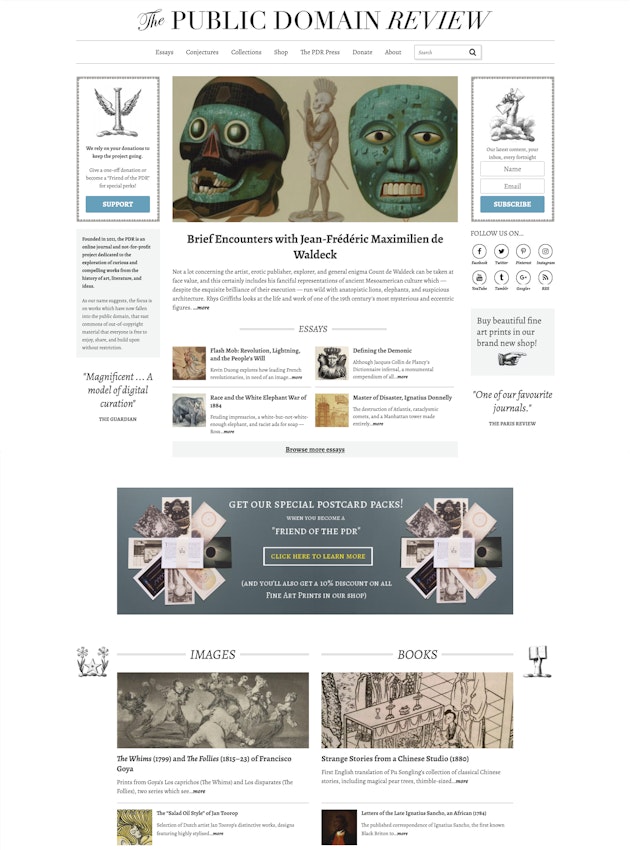 Scroll through the whole page to download all images before printing.
Scroll through the whole page to download all images before printing.Our homepage in November 2017.
Content highlights from the year:
- Alicia Puglionesi on a curious case of supposed dream telepathy at the end of the US Civil War
- John Bevis on the subterfuge techniques of a pair of wildlife photographer brothers
- Jon Crabb on woodcuts and witches
- W. E. B. Du Bois' Hand-Drawn Infographics of African-American Life (1900)
- A Journey Round my Room (1794 / 1871)
2018
There were no major changes or developments to report this year. We mainly kept our head down, publishing interesting things, and saving money so that we might, one day, be able to afford a new custom-made super-slick website free from the technical woes which seemed, with the growth of the project, to be ever-increasing.
Content highlights from the year:
2019
The year began with plotting, with our now technical lead Brian Jones, to make this new custom-made super-slick website free from technical woes a reality. Many months of late nights later and in November we finally launched the new site, a major milestone in the history of the project. Read our blog post to learn more about the new changes brought in.
No screenshots required for this one as you can just go to the current homepage :-)
Content highlights from the year:
2020
Well this year was a bonkers one, to put it mildly. We felt very fortunate to be less affected than many by the pandemic in our day-to-day operations. Although it certainly brought its own waves of strain and challenge for the project and personally too, all-in-all it turned out to be a year of great flourishing for the site with a record-number of you joining to become Friends. As March rolled in, and lockdown hit home for many of us, we gifted you the first installment of our free colouring book which was downloaded a whopping 40,000 times! Lockdowns continued and we followed this up with a second installment and also a collection of 15 image backgrounds to liven up your barrage of video chats and conferences. This summer also brought the historic Black Lives Matter protests which swept the US and many other countries around the world. For us, it was an impetus to reflect on the role cultural institutions, ours included, play in the perpetuation of racial violence and to think about what The Public Domain Review can do better moving forward.
Content highlights from the year:
- Susan Schulten on Emma Willard's “maps of time”
- Paula Findlen on the 14th-century Italian poet Francesco Petrarch and the plague
- Philip Ball on the science and stories behind the pigments
- Studies on Twilight Phenomena, after Krakatoa (1888)
- Ancient Courses: Harold Fisk’s Meander Maps of the Mississippi River (1944)
2021
And now here we are, one day into the year, on our tenth birthday!
Wherever you joined us on this decade-long journey, thank you so much for your interest and support (particularly those who donate to the project!). This is all only possible, and meaningful, because of you the readers.
“And what about birthday gifts?" I hear you ask. That really is a great question and it is indeed customary to receive gifts on one's birthday... A wonderful gift to give would be to keep spreading the good word about the PDR far and wide, there's so many out there that we know would love the project but don't know about us yet. If you haven't already, you can also sign up to our free newsletter mailing list. And if you really want to give something special to mark this momentous day then you can, of course, support the project by becoming a Friend of the PDR and help create a bedrock of support that will keep us going for another ten years and more!


